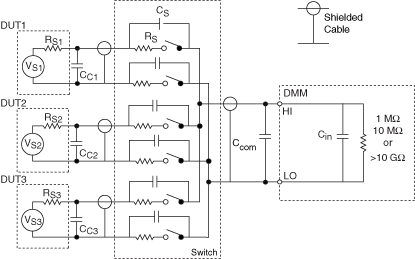Settling Time
Prior to every measurement phase, a settling time exists. Refer to DMM Measurement Defaults for the default settling times for each function of the NI 4070/4071/4072. Refer to DMM Measurement Defaults for the default settling times for each function of the NI 4065.
You can modify these values to be longer or shorter. The following figure shows a DMM connected to three devices under test (DUTs) through a multiplexing switch:

Whenever the external switch changes channels, the DMM input is connected to a different voltage or resistance. Each time this process happens, the DMM, interacting with the source, behaves as an RC circuit with a settling time that corresponds to:
ST = kRC
where
R = equivalent resistance of the source
C = the equivalent input capacitance seen by the DMM (C COM + C CX + CIN), where CCX = CC1 or CC2 or CC3 (cable capacitances) depending on the channel selected
k = value related to accuracy required, as shown in the following table; increases as required accuracy increases
ST = settling time required
 |
Note NI does not generally recommend scanning currents directly. The optimum method for scanning currents is to embed shunt resistances in the test system, then scan voltage. Refer to Load Switching for more information. |
| k | Error | Required Resolution (for full range step) |
|---|---|---|
| 3 | 4.98% | — |
| 4 | 1.83% | — |
| 5 | 0.674% | — |
| 6 | 0.248% | — |
| 7 | 0.091% | — |
| 8 | 0.033% | 3½ digits |
| 9 | 0.012% | — |
| 10 | 0.0045% | 4½ digits |
| 11 | 0.0017% | — |
| 12 | 0.00061% | 5½ digits |
| 13 | 0.00023% | — |
| 14 | 0.000083% | 6½ digits |
| 15 | 0.000031% | — |
| 16 | 0.000011% | 7 digits |
| 17 | 0.000004% | 7½ digits |
Adjusting the default settling time may be important when you are measuring or scanning resistances with values above 10 kΩ, when C >500 pF, and when speed is of the utmost importance. For the input capacitance of the DMM, refer to Related Documentation for the specifications document. The cable capacitance can be significantly more than the input capacitance. Cable material dielectric absorption complicates the settling time issue.
When switching to the next measurement, consider the following example. Assume a 10 V step occurs on the 10 V range with a required resolution of 6½ digits. Referring to the previous table for 6½ digit settling, k = 14 is required. Consider next a 10 mV step on the 10 V range. The step, being 0.1% of range (10 mV/10 V = 0.1%), can only be observed to 0.1% beyond that (assuming a 6½ digit resolution). In this example, the maximum time required from the previous table corresponds to k = 7, which yields 0.091%. If the difference between channels is known to never exceed 10 mV, then you can save considerable settling time. If you cannot predict what the values are from channel to channel, consider the accuracy required in the measurement. Then assume a step size equal to the full range to identify k.
The analysis in the previous example is for fixed range operation. You can select Auto Range for the measurement, but additional delays occur as the DMM seeks the appropriate range for the measurement. NI does not recommend Auto Range for optimum speed.